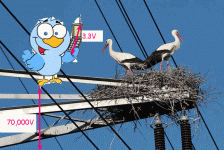I realize this may be a stupid question but.... I am considering going to DC heaters on a preamp. The original design elevated the AC heater voltage 60V. How does one accomplish the same thing if using DC? One cant just float the 6.3VDC on the 60VDC of the original design can you?
Thanks in advance.
Thanks in advance.
Yes, as long as the complete heater circuit is not grounded or connected elsewhere.
Then it can be elevated as far as is allowed by the tube and transformer voltage ratings.
Instead of the filament circuit being connected to ground, it is connected to
a high impedance voltage divider which is bypassed to ground with a capacitor.
This is necessary if one or more of the tubes is a cathode follower (unless it uses
a ss current source as a load), or otherwise has its cathode elevated substantially
above ground (cascoded, etc.). This is because tubes have a limited voltage rating
between the heater and the cathode, which cannot be exceeded.
Then it can be elevated as far as is allowed by the tube and transformer voltage ratings.
Instead of the filament circuit being connected to ground, it is connected to
a high impedance voltage divider which is bypassed to ground with a capacitor.
This is necessary if one or more of the tubes is a cathode follower (unless it uses
a ss current source as a load), or otherwise has its cathode elevated substantially
above ground (cascoded, etc.). This is because tubes have a limited voltage rating
between the heater and the cathode, which cannot be exceeded.
Last edited:
You can, if you have a floating 6.3 V DC supply. You can either just connect one terminal to 60 V DC or connect a voltage divider with two 100 ohm (or so) resistors to the 6.3 V supply and connect the mid point to 60 V DC.
SY used a center-tapped filament winding on one of the projects.
Marlin Jones Electronic Components and Accessories | MPJA.COM sells some very inexpensive DC-DC converters which relieve you the necessity of a filament winding. One pole can easily be raised above ground.
Marlin Jones Electronic Components and Accessories | MPJA.COM sells some very inexpensive DC-DC converters which relieve you the necessity of a filament winding. One pole can easily be raised above ground.
...One cant just float the 6.3VDC on the 60VDC of the original design can you?...
Bird on a wire with a cellphone.
Attachments
How do you realize filament floating in case of a double triode, if the cathode of one half is at B+/2 ? (I think on an SRPP circuit)
As Marcel said, you split the difference and check it doesn't exceed the permitted heater/cathode rating. One cathode is higher, the other lower.
I have another silly question. I use separate ground and B+ for the L and R channel of my preamplifier. It is virtually two independent amplifiers in the same box. I designed it like this for preventing ground loop. As for the heating, I use individual stabilizers with 6.3VDC output for each tube. The stabilizers are supplied from a common (floating) diode bridge and reservoir capacitor. How do I elevate the heating? Use a divider and a bypass capacitor on the R (or L) channel only? Is there any better solution? Do I overthink it?
Using just one preamp's divided/filtered B+ to connect to the heater supply of both preamps may add some ground loop noise to the heater feed of the other preamp. It may not be noticeable as the ground loop noise between preamps may be insignificant, and/or your tubes may have adequately low heater-cathode resistance and capacitance, and/or the elevation may be assisting the heater-cathode resistance performance.
The assumption is that each preamp B+ uses a separate HV winding/rectifier/filter/0V, and there is one star point where each preamp 0V and the chassis connect. Even though it may seem that all noise currents will flow along the 0V of each preamp and only connect at the star point, there are many capacitive coupling paths that don't follow that 'rule' for many different signals (mains, hum, each channel's signal).
The assumption is that each preamp B+ uses a separate HV winding/rectifier/filter/0V, and there is one star point where each preamp 0V and the chassis connect. Even though it may seem that all noise currents will flow along the 0V of each preamp and only connect at the star point, there are many capacitive coupling paths that don't follow that 'rule' for many different signals (mains, hum, each channel's signal).
- Home
- Amplifiers
- Tubes / Valves
- Silly Heater Elevation Question.
